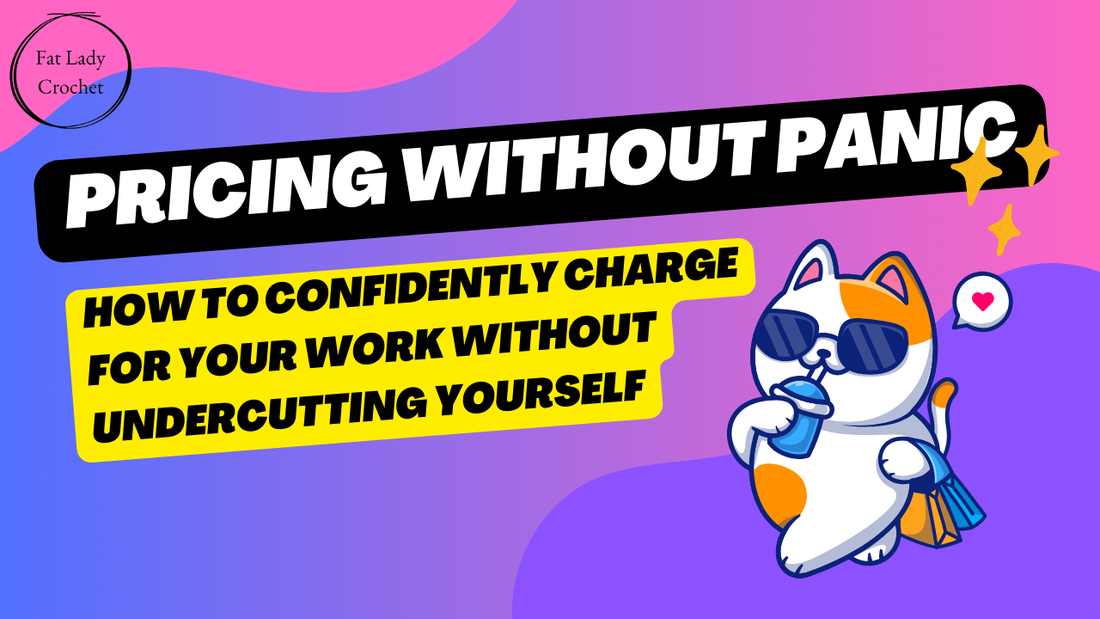
Pricing Without Panic: How to Confidently Charge for Your Work Without Undercutting Yourself
Trish HoskinShare
Ah, pricing. The five-letter word that sends even the most seasoned creatives into a cold sweat. You know the scene: you’ve just made something incredible, and now it’s time to put a price tag on it. Your brain spirals into chaos:
“Is this too much?” “What if no one buys it?” “Will people think I’m greedy?” “Can I survive on three bucks and a latte a day?”
Take a deep breath, my friend. Pricing doesn’t have to be a horror show. Let’s break this down and get you pricing with confidence—and without the emotional breakdown.
Step 1: Understand Your Worth (and Stop Apologizing for It)
First things first: you’re talented. You’re experienced. You’ve spent time—maybe years—honing your craft. So why are you charging like you’ve just stumbled out of your first crafting class, still covered in glue?
Here’s the secret: you’re not just charging for the finished product. You’re charging for your skill, your creativity, your time, and the emotional labor of not throwing your project across the room halfway through.
Stop pricing like you owe the world a favor. You’re not a charity. Unless, of course, you are a charity—in which case, this blog post isn’t for you.
Step 2: Do the Math (Yes, Math. Don’t Panic!)
Now let’s get nerdy. To figure out your prices, consider these factors:
- Cost of Materials: Yarn, hooks, glitter, coffee (for survival), etc.
- Time Spent: How many hours did it take? Multiply that by your desired hourly rate. (Hint: your time is worth more than minimum wage.)
- Overhead Costs: That’s electricity, tools, subscriptions, and other business expenses.
- Profit Margin: Because you’re running a business, not a high-stakes game of “How Little Can I Earn and Still Eat?”
Add it all up. Then double-check your math. Then, if your inner critic whispers, “But what if people think it’s too expensive?” you’re officially on the right track.
Step 3: Research the Market (But Don’t Get Obsessed)
It’s a good idea to look at what others in your niche are charging. Notice I said “others in your niche,” not random Etsy shops selling the crochet equivalent of soggy cereal. Compare your work to people offering similar quality and craftsmanship.
Then, remember that you don’t have to be the cheapest option. You’re not a bargain bin; you’re a boutique.
Step 4: Practice Saying Your Prices Out Loud
Here’s where things get fun. Stand in front of a mirror and say, “This item costs $X.” Repeat until you can do it without laughing, cringing, or apologizing to the imaginary customer in your head. Confidence is key.
If someone says, “That’s too expensive,” you’re allowed to smile politely and say, “Thanks for your feedback!” (And then go sell to someone who values your work.)
Step 5: Add “Special Tax” for Pain-in-the-Butt Projects
Let’s be real: some projects are more demanding than a toddler in a toy store. Intricate details, custom requests, or clients who email you at 2 a.m. with “one more tiny change” all deserve an extra fee. Call it a “pain-in-the-butt tax.” It’s fair. It’s necessary. It’s non-negotiable.
Step 6: Be Ready to Justify Your Prices (But Not Too Much)
Sometimes, people will ask why your prices are “high.” That’s your cue to hit them with facts:
- “I use high-quality materials that last.”
- “My work is handcrafted and unique.”
- “This took X hours to create, and my time is valuable.”
You don’t owe anyone a TED Talk on your pricing strategy. A simple explanation will do.
Step 7: Set Boundaries and Stick to Them
If you’ve priced your work fairly and someone still tries to haggle, it’s okay to say no. Repeat after me: “I’m not a flea market.” Discounting your work devalues your time and talent. Save the discounts for sales, promotions, or that one friend who keeps your caffeine habit alive.
Final Thoughts: You Deserve to Be Paid What You’re Worth
Pricing isn’t about making everyone happy. It’s about making your business sustainable and your hard work worthwhile. Charge confidently, laugh at the hagglers, and remember: you’re not just selling a product. You’re selling a piece of yourself—and that’s priceless.
